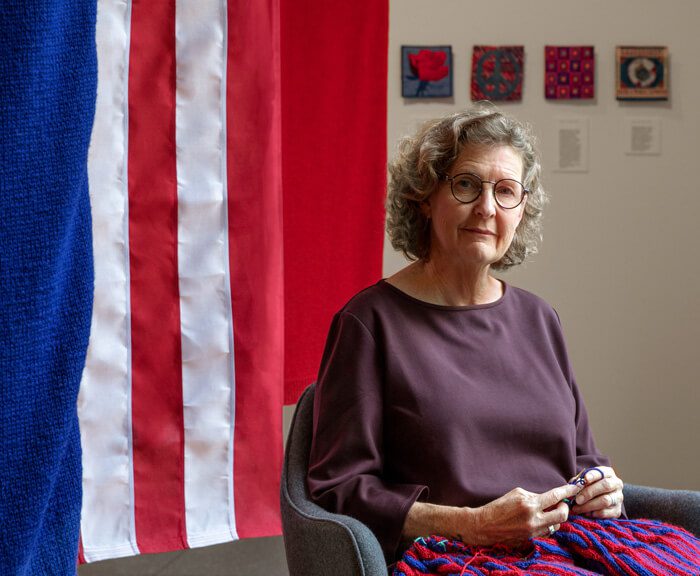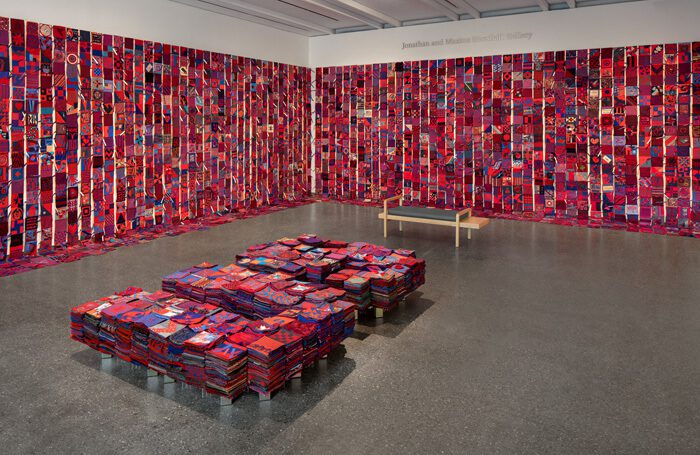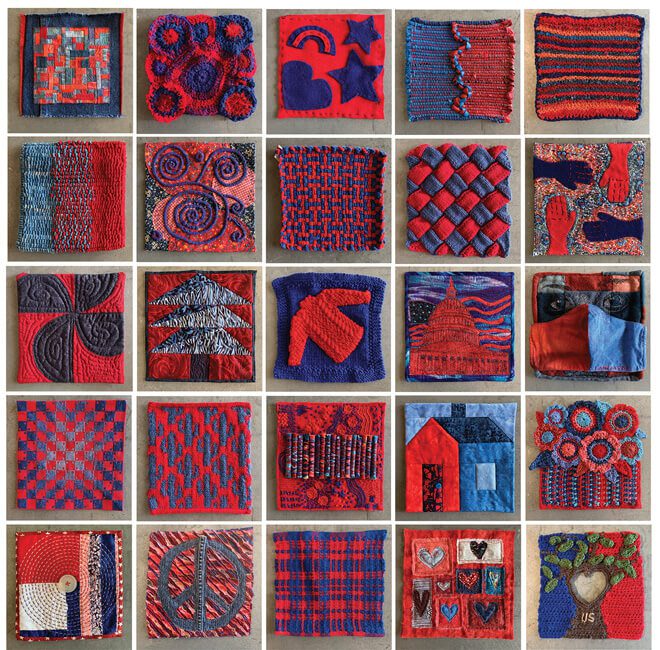Ann Morton tackles divisive politics with The Violet Protest, a Phoenix Art Museum exhibition that, once deinstalled, will be mailed piecemeal to every member of the United States Congress.

PHOENIX, AZ—It’s an August afternoon and artist Ann Morton knits inside a gallery at the Phoenix Art Museum, where she’s building a large-scale sweater for one of three American flags suspended nearby. Two walls across the gallery are covered with vertical banners of textile squares, created with shades of red and blue that hint at the intentions of their makers.
Every artwork in Ann Morton: The Violet Protest—which features more than 12,000 artworks by people in all fifty states and beyond—measures eight inches square, and no two designs are alike. Some are displayed in a horizontal line across a gallery wall. Most are stacked at the center of the exhibition space, sculpting an installation with the letters “U” and “S.”
Collectively, they speak to the issue of bipartisanship, even as legislators struggle to find common ground on voting rights, infrastructure, and other issues of the day. The Phoenix-based artist conceived the project as a way to counter the rise of divisive rhetoric and partisan politics while elevating principles she learned as a child, including compassion, creativity, and compromise. Shortly after the exhibition comes down later this month, select artworks will be sent to every member of the United States Congress in order to encourage political goodwill.
“We have some hard problems to solve,” Morton says of the challenges facing contemporary society. “We can’t always agree on the solution, but we can be steadfast in upholding our core American values.”
Morton first put out the call in January 2020, inviting people to submit textile pieces that would become part of this larger body of work. At last count, 2,292 participants had delivered artwork for the project, representing more than 75,000 hours of handiwork.

The Southwest is well-represented, but there’s enough disparity to inspire a little friendly competition. As of August 28, Morton had received 4,628 squares from Arizona, 688 from Texas, 424 from Colorado, 377 from New Mexico, 184 from Utah, and thirty-six from Nevada.
Makers submitted squares fashioned with all sorts of materials, including denim, ribbon, felt, yarn, lace, buttons, and beads. “Some of the people who made squares are artisans, but a lot of them are people who’ve never sewn anything before,” Morton says.
More than 17,000 people pledged to submit squares, which helps explain why Morton is still receiving and installing new artworks on a regular basis—the central installation at the Phoenix Art Museum has grown visibly taller over time.
One maker set a bumblebee atop a red flower with a blue background, adding the words “Bee Kind.” Another crafted a quilted piece, layering various hues of red and blue to create a mountain sunset. Several used tree imagery and others generated designs that nod to their home states.
“It’s a form of soft protest,” says Morton, “but it’s still a protest.”

Morton will accept squares through mid-September (although the official deadline was August 1), so you still have time to make your mark—assuming you can visually and materially balance the artwork in equal parts of red and blue. She asks creators to avoid political content but notes that pieces often mirror personal or cultural touchstones.
The artist has been emotionally moved by a number of the submissions. Shortly after Supreme Court Justice Ruth Bader Ginsburg died last September, Morton received a square depicting the scales of justice. Days after the January 6 events at the U.S. Capitol, an artwork arrived with the word “courage” set against the backdrop of a jagged-edged rose that reminded her of glass shards from broken windows.
“We got one square from a woman who learned about the project after her husband’s funeral,” Morton recalls. “For her, making the artwork was therapeutic.”
The bipartisan tone of The Violet Protest, which remains on display through September 5, 2021, reveals a significant departure from Morton’s previous political works, first undertaken during the George W. Bush era as a way to express her own personal concerns. Most recently, Morton produced a series of white handkerchiefs called Proof Reading using red and blue embroidery thread to engage with language culled from tweets and speeches by former President Donald Trump.
Today, she’s laser-focused on the U.S. Congress.

Morton plans to send fifty squares from The Violet Protest to every member. With 535 legislators, she’ll need a total of 26,750 squares.
Most will be mailed through the U.S. Postal Service, something Morton describes as “another little form of resistance.” It’s her way of countering “Trump’s attempts to decimate the post office” in 2020. In addition, organizers are working on options for displaying the project in Washington, D.C., and personally presenting squares to key legislators.
“I hope that seeing all these artworks created by people from around the country will make them more open-minded,” Morton says of the 117th Congress. “I’m not under any illusion that this will change every heart and mind, but for the people who participated, it’s a way to be part of a larger conversation and have their voices heard.”



